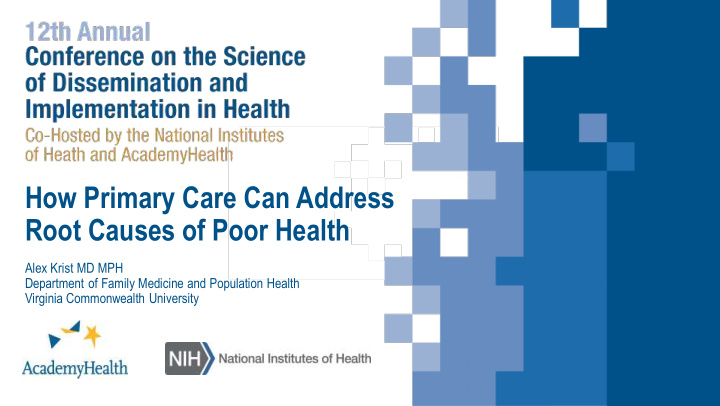



1 How Primary Care Can Address Root Causes of Poor Health Alex Krist MD MPH Department of Family Medicine and Population Health Virginia Commonwealth University
Disclosures 2 Financial conflicts of interest • None Funding • Agency for Healthcare Research and Quality (R01HS02622-01A1), National Center for Advancing Translational Sciences (UL1TR002649), and National Cancer Institute (R01CA166375-01A1) Other • Although I am a member of the U.S. Preventive Services Task Force (USPSTF), materials provided in this presentation reflect my individual views only and do not represent the views or recommendations of the USPSTF except where noted on individual slides. The overall presentation should not be attributed to the USPSTF.
Short distances can lead to large gaps in health 3
Factors contributing to premature death 4
Study on screening for social risks in primary care 5 • 12 primary care practices in Northern Virginia National Academy of Medicine Measures • Geocoded all patients’ place of residence and linked to census tract data on education, income, Social Deprivation Index (SDI), and life expectancy • Asked clinicians to screen patients living in “cold spots” for social risks • Learning collaboratives and point of care clinician diaries to reflect on how knowing place- based and patient reported information changed encounters
Needs were common… but patients only wanted to address a few 6
Theme 1: Assessing social needs is difficult and resource intensive 7 • “The patient was very reluctant to complete the survey. He did not report any social needs […] however, I actually suspect the patient has a number of social needs.” • “ The people who really need it may not be the ones who are actually coming in .” • “We’re doing too many things. We have too little time.”
Theme 2: Few resources exist to help patients 8 • “Our resources as a practice are limited […] we can’t be doing some of these things. We have to think about what we really want to accomplish.” • “One problem is we don’t know what resources are even in our community.” • “ It doesn’t do you much good in a system to identify problems if the system doesn’t have any way to address them .”
Theme 3: Screening helped clinicians know their patients better 9 • “It’s a reminder that our patients, in filling out these surveys and learning more about them, that our patients have lives outside of just the medicine we given them .” • “The patient had a new diagnosis of diabetes and told me she did not go to the diabetes education classes because they were $250 per class. With the survey, my reaction was more understanding and I was less inclined to assume she did not care about her health .”
Theme 4: More evidence needed about how to collect and address 10 social needs, as well as its impact on health outcomes • “I think the bottom line is: Does it improve health outcome? […] Does it actually help the patient? ” • “We’re not asking the right questions. It makes me think what would be the right questions to ask to identify things that the doctor might be able to help with.”
Despite troubles clinicians reported screening changed visits 11 Social needs survey helped me know 52% 41% 7% patient better Social needs survey helped change care 23% 77% Knowing patient lives in a "cold spot" 33% 63% 3% helped during the encounter Information from social needs survey 34% 64% 2% helped during encounter 0% 20% 40% 60% 80% 100% Positive Neutral Negative
CMMI made $157M available through Accountable Health 12 Communities for delivery of social services
Next phase: care planning for root causes of poor health 13 • Objective: To develop and test whether an enhanced care planning strategy for primary care practices to partner with community programs to address health behaviors, mental health, and social risks is better than traditional medical care. • Design: Clinician level randomized controlled trial. • Setting: 60 primary care clinicians in Richmond, building on Accountable Health Community. • Population: 600 patients (10 per clinician) with multiple uncontrolled chronic conditions will be randomly selected to participate. • Outcome Measures: From EHR data and patient surveys, we will measure improvements in chronic conditions and patient reported measures (physical health, mental health, social wellbeing) six months and 12 months post-enrollment.
Model for how primary care can have a role addressing needs 14
Care planning process… linked to patient navigator 15
Distribution of community programs versus need 16 All programs vs. life expectancy Financial aid programs vs. poverty
17 THANK YOU! • Alex Krist MD MPH • Virginia Commonwealth University @AlexKristFP alexanderkrist@vcuhealth.org
Recommend
More recommend